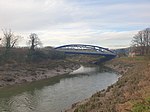St Philip's Footbridge
2019 establishments in EnglandBridges completed in 2019Bridges in BristolBristol building and structure stubsPedestrian bridges in England ... and 1 more
United Kingdom bridge (structure) stubs

St Philip's Footbridge is a footbridge in Bristol, UK that crosses the River Avon. It is currently only accessible from the east as the western entrance has been fenced off.
Excerpt from the Wikipedia article St Philip's Footbridge (License: CC BY-SA 3.0, Authors, Images).St Philip's Footbridge
St Philips Footbridge, Bristol Totterdown
Geographical coordinates (GPS) Address External links Nearby Places Show on map
Geographical coordinates (GPS)
| Latitude | Longitude |
|---|---|
| N 51.446527777778 ° | E -2.577275 ° |
Address
St Philips Footbridge
St Philips Footbridge
BS2 0XA Bristol, Totterdown
England, United Kingdom
Open on Google Maps








